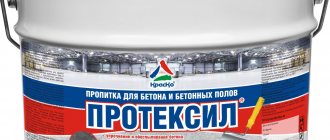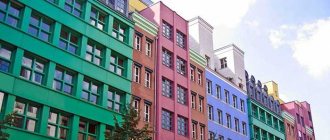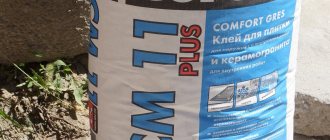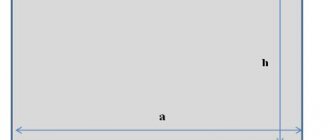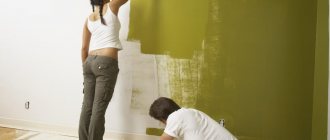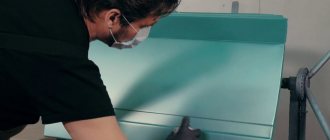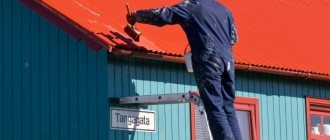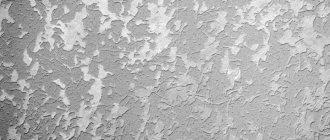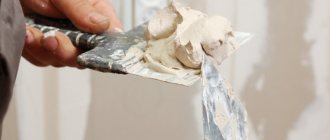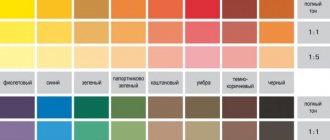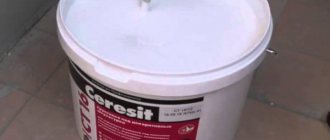Due to the use of material reinforced with fiber, the resistance of the base to abrasion increases, the surface can withstand more freeze/thaw cycles, and the occurrence of cracks and moisture penetration is eliminated.
Advantages of fiber windows
The main task of fiberglass is to strengthen the screed. Without reinforcement, it is not so strong and rigid in bending. Plus, the addition of fiber greatly reduces the risk of cracking of the rough layer on the floor during hardening and shrinkage after pouring. As the gypsum and cement-sand mortar hardens, water comes out in small quantities. If the floor screed is poured in a thick layer and not reinforced, it will become covered with small cracks, which will then inevitably begin to expand and destroy the coating.
Distribution of fiber in screed solution
The use of fiberglass allows you to:
- avoid separation of the setting mortar;
- prevent microcracks from appearing in it;
- increase the strength of the coating against fracture and point loads several times;
- reduce the amount of water used and minimize the formation of voids inside the concrete;
- reduce the hardening time of the mixture by 2–3 times;
- improve the frost resistance of the screed by 7–10 times;
- increase the abrasion resistance of the base under the finish by 30–40%.
Hardened cement screed with fiber
With proper use of fiber, the strength characteristics of the floor screed increase by 3–5 times. Very little reinforcing material is consumed. And the markup he gives is no more than a couple of percent of the cost of the prepared solution. At the same time, the main competitor of fiberglass, metal mesh, will cost almost an order of magnitude more. And working with the latter is much more difficult than with fine fiber added to the kneading composition.
Advantages of fiber screeds
Preparation for reinforcement
Preparatory work is carried out according to general principles. The site on which the concrete base will be installed is cleared of debris, dust and third-party objects. At the same time, the rough surface itself should not have serious defects. If available, use primer and grout mixtures. The coating on which the mortar and screed fiber will be laid must not only be clean, but also smooth. Next, wooden or plastic beacons are placed, forming in some way the contours of the formwork. The base of the screed will be located within the formed boundaries.
Types of fiber fiber
Fiber for floor screed is a microfiber with a thickness of 10 microns to 2 mm and a length of 3–25 mm, depending on the type. There are options with other sizes, but they are used in other areas of production and construction. For installation of poured floor coverings, it is recommended to use only material with the above parameters.
Types of fiber for screed
Fiber fiber is made from:
- become;
- basalt;
- polypropylene;
- glass
In terms of general characteristics and effects on the solution, they are all the same. But each of these varieties also has its own distinctive pros and cons.
Steel fiber
Steel fiberglass for screeds is distinguished by its heavy weight, fire resistance and increased resistance to temperature changes. It is usually used when pouring thick concrete floors in industrial and commercial facilities. Its main disadvantage is its susceptibility to rust. Even with a special brass coating and being inside concrete, steel fiber still begins to rust over time, losing its characteristics.
Basalt
The basalt analogue is also not afraid of fire and temperature changes. But the main thing is that it is not afraid of moisture and aggressive chemicals. If you need to reinforce the screed with fiberglass on the floor in a bathroom, steam room or garage, then basalt will be the most optimal choice.
Advantages of basalt fiber
Polypropylene
Polypropylene fiber for screeds is the most common now. It is distinguished by its low weight and resistance to moisture. A floor reinforced with such fiber fiber increases not only its strength but also its sound insulation characteristics. The main disadvantage of this option is its susceptibility to melting at high temperatures, which can occur even during a small fire.
Fiberglass
Glass fiber is characterized by high ductility and the lowest strength among analogues. This is more an option for plaster mixtures. But if the floor screed is made 2–3 cm thin, then it is best to choose fiberglass for its reinforcement. Here glass wins over polypropylene, basalt and steel.
Main components of the supplement
The technology for manufacturing additives depends on the type of reinforcing components used. Not all fibers meet the requirements for reinforcement cages.
Metallic and non-metallic threads of different lengths and cross-sections are used as fibers:
- In terms of construction, the greatest effect is obtained from the use of steel fibers, the deformability modulus of which is 6 times higher than that of concrete.
- The use of polypropylene can reduce the risk of cracking during plastic shrinkage of mixtures by 60-90%.
- Glass fiber has low alkali resistance and is used only for preliminary reinforcement in the manufacture of gypsum products or wall blocks made of cellular concrete.
- Basalt fiber is resistant to alkaline processes. The elastic modulus is 15-20% higher than that of glass fibers.
- Asbestos fibers are neutral to the aggressive effects of cements and are characterized by high strength and fire resistance.
A rational choice of additives for concrete reinforcement makes it possible to obtain products that are resistant to mechanical loads.
Fiberglass has low alkali resistance.
How to choose fiberglass for screed?
When choosing the material in question, you should take into account not only its price per kilogram, but also the consumption of fiber fiber of one type or another per cubic meter of solution. Steel fibers will consume the most weight, and polypropylene fibers the least. At the same time, the steel version is much cheaper than the polymer one. And fiberglass and basalt are somewhere in between.
Popular material manufacturers
If, when deciding how to choose plastic windows, you have to analyze the thermal conductivity and number of chambers of various proposals, then with fiberglass the main thing is the consumption per 1 m3 and the price per 1 kg. Moreover, these two figures must be considered together, and not separately.
Based on the combination of characteristics and final cost, in most cases it is recommended to choose polypropylene fiber. It is expensive, but is consumed in the smallest volumes per cubic meter of solution. But if you need a reinforcing material for a thin layer or one without much strength, then you should take basalt fiber at a lower price. However, a lot here depends on the required properties and thickness of the subfloor.
What to look for when buying fiber
Buying low-quality fiber is not only a waste of money, but also a risk of ruining the structure. Concrete structures are manufactured with strength and long service life in mind. The use of low-quality materials can lead to significant losses.
For example, you can find handicraft polypropylene fiber on the market. In appearance, it differs little from factory fiber, but is manufactured in violation of technology. High-quality fiber contains a component called lubricant. It prevents fibers from clumping and promotes their uniform distribution in the solution. The fake fiber will crumple, and the formation of a three-dimensional frame in the thickness of the concrete will not occur, which means that the concrete will not receive the properties that were expected when the fiber was added. By “saving” a few rubles, you can incur significant losses.
To avoid such situations, purchase fiber from trusted manufacturers from reliable suppliers.
Making screeds with fiber fiber
The construction of a reinforced screed using fiber fiber occurs in five stages:
- Preparing the base.
- Installation of beacons by level
- Laying damper tape.
- Mixing the solution with the addition of fiber.
- Laying out (pouring) the mixture and leveling it on the floor.
Preparation of a solution with fiber
It is recommended to add fiber fiber in two stages. Half when hanging “dry”. And half after adding water to the mixture. For fiberglass, polypropylene and basalt fiber, the recommended consumption is about 0.5–1 kg/m3. And the steel analogue will have to be added about 25–50 kg/m3.
Preparation of mortar for screed
Like the damper tape for floor screed, reinforcing fiber is not afraid of the effects of alkalis inherent in concrete. It calmly tolerates the process of dehydration that occurs during the hardening of cement-sand and gypsum mortars. There is no need to add any additives to the mixture here. It is enough to mix all the components into a homogeneous mass and then add clean water.
Cement screed with fiber
The construction of screeds with and without fiber, semi-dry and classic wet technologies differs little. The work processes are approximately the same in all cases. With the reinforcement under consideration, the main thing is to evenly mix the fibers in the solution so that they do not collect in a lump on any one area of the floor. Otherwise, everything happens according to the usual pattern.
The type of fiber fiber also does not particularly affect the procedure for mixing the solution. Thinking about how to connect a boiler to water depending on its type will require serious consideration and a careful assessment of various factors. The fiber just needs to be added to the mixture being kneaded. This ease of installation distinguishes it from its direct competitor – reinforcing mesh.
Classic reinforcement made of rods or polypropylene must not only be laid out on the floor, but also fixed at a certain height. After all, it must be inside the concrete. And the fiber fiber, after mixing all the required components, is already in the solution.
Floor installation with screed
Material characteristics
Plastic fiber usually contains one component - polypropylene. The density of the material varies from 0.9 to 0.95 g/cm3, which indicates a sufficient quality of fiber stiffness. It cannot be said that it is comparable to the performance of the same steel mesh, but it is quite sufficient for a home screed. Moreover, the function of mechanical strengthening in this case is not so important. Dimensional characteristics are very diverse. Thus, the diameter of the fibers can be from 15 to 25 microns, and in length - from 6 to 20 cm. It is important to note that the fiber for the screed, unlike reinforcement or mesh reinforcing layers, is often a crumbly fibrous material, therefore the standard sizes are conditional character.
